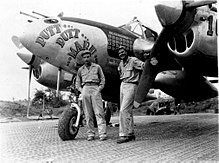Charles H. MacDonald
Charles Henry "Mac" MacDonald | |
|---|---|
 Col. MacDonald and Al Nelson next to "Putt Putt Maru" | |
| Nickname(s) | "Mac" |
| Born | November 23, 1914 Dubois, Pennsylvania, U.S. |
| Died | March 3, 2002 (aged 87) |
| Allegiance | |
| Service/ | United States Army Air Corps |
| Years of service | 1938–1961 |
| Rank | |
| Unit | 55th Pursuit Group 18th Pursuit Group 326th Fighter Group 348th Fighter Group 340th Pursuit Squadron 475th Fighter Group 33rd Fighter Group 23rd Fighter Wing |
| Commands held | 340th Pursuit Squadron 475th Fighter Group 33rd Fighter Group 23rd Fighter Wing |
| Battles/wars | World War II |
| Awards | Distinguished Service Cross (w/ Oak Leaf Cluster) Silver Star (w/ OLC) Legion of Merit Distinguished Flying Cross (w/ 5 OLCs) Air Medal (w/ 10 OLCs) Air Force Commendation Medal American Defense Medal Asiatic Pacific Campaign Medal American Campaign Medal World War II Victory Medal |
Colonel Charles Henry "Mac" MacDonald, USAF, (November 23, 1914 – March 3, 2002) was an American fighter ace. MacDonald commanded the 475th Fighter Group for 20 months in his P-38 Lightning, "Putt Putt Maru" with the unit number "100" and becoming the third ranking fighter ace in the Pacific during World War II.
Early life
MacDonald was born in Dubois, Pennsylvania on November 23, 1914. He entered the U.S. Army Air Corps pilot training program after graduating from Louisiana State University in 1938. He received his flight wings and was commissioned a Second Lieutenant at Kelly Field, Texas on May 25, 1939. His first assignment was to the 55th Pursuit Group, he later transferred to the 18th Pursuit Group at Wheeler Field, Hawaii on February 9, 1941 and was at Pearl Harbor on December 7, 1941.
World War II
MacDonald then served in the United States with the 326th Fighter Group before transferring to the 348th Fighter Group to command the 340th Pursuit Squadron at Westover Field, Maine. On October 1, 1943, then a major, joined the 475th Fighter Group at Dobodura, New Guinea as the group executive officer. He scored his first four victories that month and became an ace on November 9, 1943 when he downed two Zekes near Alexishafen Airdrome. He was promoted to lieutenant colonel the following day on November 10, 1943 and became the group commander. He finished the war with 27 confirmed victories, making him the third highest ranking U.S. Army fighter pilot of the Pacific Theater.
Later life
MacDonald returned to the United States in July 1945 where he served in various staff and command assignments, including the 33rd Fighter Group and 23rd Fighter Wing commander, Air Attaché to Sweden, and instructor at the US War College in Washington, D.C. before retiring from the Air Force as a colonel in July 1961. Colonel MacDonald's retirement ceremony at McChord AFB near Tacoma, Washington included a performance by the USAF Thunderbirds and a declaration of 'Col. Charles MacDonald Day'. He then moved to Anacortes, Washington where he opened a real estate business selling island properties in Puget Sound (an excuse to pursue his love of sailing) and his four children finished High School. In 1971 he closed the real estate business, sailed to Mexico, and in 1973 returned to San Diego, California where he and his wife sold the boat that he had first purchased while in Sweden. They spent the next year building a new boat then Colonel MacDonald and his wife spent their time sailing the Pacific and the Caribbean until her death in 1978. He then came ashore and settled back to where he grew up in Mobile, Alabama.
Decorations
 Distinguished Service Cross with oaf leaf cluster
Distinguished Service Cross with oaf leaf cluster Silver Star with oak leaf cluster
Silver Star with oak leaf cluster Legion of Merit
Legion of Merit Distinguished Flying Cross with five oak leaf clusters
Distinguished Flying Cross with five oak leaf clusters Air Medal with ten oak leaf clusters
Air Medal with ten oak leaf clusters Air Force Commendation Medal
Air Force Commendation Medal American Defense Service Medal
American Defense Service Medal American Campaign Medal
American Campaign Medal Asiatic-Pacific Campaign Medal
Asiatic-Pacific Campaign Medal World War II Victory Medal
World War II Victory Medal
See also
Notes
References
This article includes a list of references, related reading, or external links, but its sources remain unclear because it lacks inline citations. (April 2009) |
Book
- Crocker, H.W. (2006). Don't Tread on me: A 400-year history of America at War, from Indian Fighting to Terrorist Hunting. Crown Forum. ISBN 1-4000-5363-3.
{{cite book}}: Cite has empty unknown parameter:|coauthors=(help)
Web
- "Col. Charles H. MacDonald, C.O. 475th Fighter Group - 27 kill ace". Ace Pilots. AcePilots.com.
- "475th's Aces". Colonel Charles H. MacDonald.
- "History of the 475th Fighter Group". 475th Fighter Group Historical Foundation.
- LSU Cadets of Ole War Skule Hall of Honor Honoree 2003
Further reading
- Stanaway, John (1993). Possum, Clover & Hades: The 475th Fighter Group in World War II. Schiffer Publishing. ISBN 0-88740-518-5.
- Stanaway, John (2007). 475th Fighter Group. Osprey Publishing. ISBN 1-84603-043-9.
- Stanaway, John (1997). P-38 Lightning Aces of the Pacific and CBI. Osprey Publishing. ISBN 1-85532-633-7.
- 1914 births
- 2002 deaths
- American World War II flying aces
- American military personnel of World War II
- Aviators from Pennsylvania
- Louisiana State University alumni
- People from DuBois, Pennsylvania
- Recipients of the Legion of Merit
- Recipients of the Distinguished Flying Cross (United States)
- United States Army Air Forces officers
- United States Army Air Forces pilots of World War II
- Recipients of the Air Medal
- Recipients of the Silver Star
- Recipients of the Distinguished Service Cross (United States)
- United States Air Force officers
